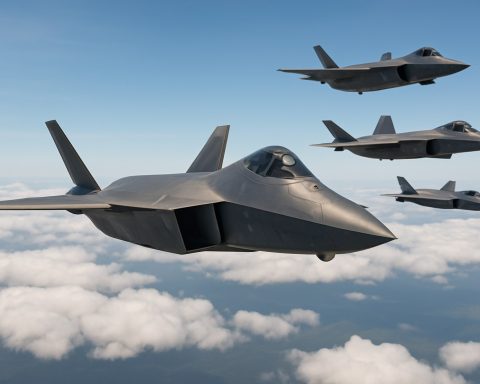- Tensions reignited as the Israel Defense Forces intercepted a projectile from Gaza, disrupting an otherwise tranquil evening.
- The interception aimed to protect the Beersheba region, targeted by a projectile intended for the Hatzerim Air Force Base, claimed by Palestinian Islamic Jihad.
- This incident is a reflection of the persistent and complex conflict between Israel and Gaza, marked by ongoing political and historical tensions.
- The event demonstrates the fragile equilibrium in the region and highlights the constant risk of escalation.
- It calls for urgent understanding, dialogue, and diplomacy to prevent further conflict and strive towards lasting peace.
An evening that could have ended in tranquility instead exploded into tension in the skies over Israel. As the sun dipped behind the dusty horizon, a streak of fire marked the silhouette of conflict between the Gaza Strip and southern Israel. The Israel Defense Forces (IDF) initiated an interceptor—searing through the air with precision—to neutralize a projectile that defied the border from the northern realms of Gaza.
With the night’s serenity shattered, the aftermath of the interception is under careful scrutiny by military analysts and experts, seeking clarity in the chaos. The projectile’s trajectory seemed clear: a direct line to the Beersheba region, an area swathed in silent anticipation for impending alerts that, this time, never came.
Far from an isolated incident, the responsibility for this escalated tension was quickly claimed by the Palestinian Islamic Jihad. Their objective: the Hatzerim Air Force Base, a significant military stronghold which radiates strategic importance. This declaration fans the flames of a longstanding conflict, a reminder that beneath the surface of daily life, the embers of unrest smolder continuously.
The landscape of conflict between Israel and Gaza is complex, a tangled web of politics, history, and deeply-held grievances. Over the decades, numerous ceasefires and peace talks have attempted to pave a way forward, yet the shadow of mistrust lingers, occasionally erupting in fiery displays like this recent incident.
In the grand theater of international relations, this event underscores the fragile equilibrium maintained in this volatile region. For onlookers, it is a stark reminder of the delicate balance and the ever-present possibility of escalation.
The resonance of these events is a clarion call for understanding and dialogue—an urgent reminder of the shared humanity that belies borders and ideologies. In every interception, in every proclaimed attack, lives are touched, altered, and scarred. And in these heartbeats of tension, one key question rises: how do we navigate toward peace?
As we watch and wait, the world turns its gaze to the resilience of diplomacy and the often fragile threads that hold communities together, reminding us of the vital need for breakthroughs in peace—before the skies light up again.
The Unseen Layers of Conflict: Exploring the Complexities in Israel and Gaza Relations
The recent interception over the skies of Southern Israel serves as a poignant reminder of the ongoing and deeply intricate tensions between Israel and the Gaza Strip. As the Israel Defense Forces (IDF) managed to neutralize the projectile directed at the Beersheba region, it’s essential to delve deeper into the multi-faceted aspects of this conflict, assessing its historical context, political nuances, and potential pathways to peace.
Real-World Use Cases: Understanding the Dynamics
1. Military Strategy and Defense: The use of interceptors by the IDF highlights the advanced military strategies employed for national defense. This not only involves technology but also strategic positioning of defense systems close to vulnerable regions like the Beersheba.
2. Diplomatic Relations and Ceasefires: Over the years, numerous ceasefires have been brokered, with significant international involvement. However, these often prove temporary due to underlying mistrust and political rifts.
3. Impact on Civilians: The ripple effect on the daily lives of civilians can’t be overstated. Communities live under the constant threat of escalation, affecting mental health and economic stability.
Market Forecasts & Industry Trends
The defense industry is expected to see continued investment and technological advancement. The demand for cutting-edge defense systems, like those used by the IDF, will likely surge globally as regions prioritize national security.
Features, Specs & Pricing: Interceptor Systems
While details about the IDF’s specific interceptor systems are generally classified, these systems typically include state-of-the-art radar technology capable of detecting launches and targeting incoming threats with precision-guided interceptors.
Controversies & Limitations
1. Ethical Concerns: The heavy militarization of regions poses ethical questions about civilian safety and the proportionality of responses.
2. Political Stalemates: The persistent gridlock in peace negotiations often overshadows efforts to find lasting solutions, with each side entrenched in its own narrative.
insights & Predictions
Experts predict that without meaningful dialogue and engagement from international actors, the cycle of tension may persist. Innovative diplomatic strategies and grassroots peace-building efforts are vital for sustainable peace.
Pros & Cons Overview
Pros:
– Advanced military technology provides security.
– Ongoing international diplomatic efforts highlight global interest in peace.
Cons:
– The enduring conflict causes immense human suffering.
– Ceasefires often break, leading to renewed violence.
Actionable Recommendations
– For Policymakers: Prioritize diplomatic negotiations, focusing on sustainable peace agreements.
– For Communities: Engage in cross-border dialogue initiatives to foster understanding and reduce misconceptions.
– For International Observers: Support peace-building organizations and initiatives financially and politically.
Suggested Related Links
For more on the latest global news and military advancements, visit CNN and for insights on international relations, explore BBC.
In conclusion, the path to peace requires cooperative efforts, patience, and a profound commitment to dialogue. By understanding the multifaceted layers of these conflicts and striving for innovative solutions, the possibility of peaceful skies may yet be realized.







